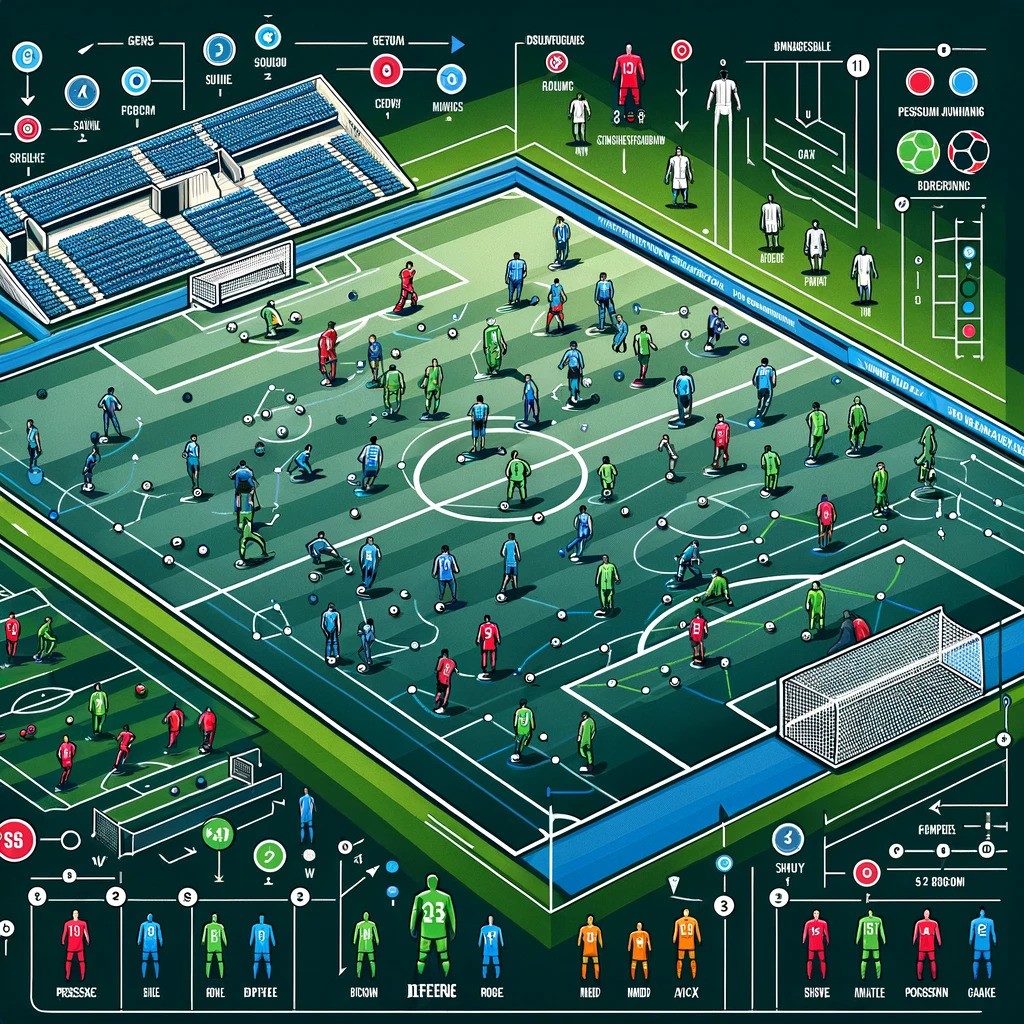9v9 soccer is a variant of the traditional soccer game, tailored primarily for youth and amateur players. This format is increasingly popular due to its focus on both skill development and tactical understanding. In 9v9 soccer, each team fields nine players, including a goalkeeper, which is fewer than the standard eleven in traditional soccer. This reduction in team size creates more space on the field, allowing players to have more touches on the ball, thereby improving their technical skills and understanding of the game.
The 9v9 format is particularly beneficial for youth players as it bridges the gap between smaller-sided games, like 7v7, and the full 11-a-side game. It offers a more manageable environment for young players to develop their skills without the potential overwhelm of a larger field and more players. This setup is crucial for fostering a deeper understanding of tactical roles and positions, making it an ideal stepping stone in youth soccer development.
The popularity of 9v9 soccer has surged in recent years, especially within youth leagues and amateur setups. Its growth can be attributed to its effectiveness in player development and its suitability for players at various skill levels. By reducing the number of players on the field, 9v9 soccer allows for more individualized coaching and focused skill development. This personalized approach helps players improve more rapidly and gain confidence in their abilities.
The Rules of 9v9 Soccer
Field Dimensions
The field dimensions for 9v9 soccer are smaller than those of a standard soccer pitch. While the exact size can vary, a typical 9v9 field is about 70-80 yards long and 45-55 yards wide. These reduced dimensions create a more compact playing area, which is crucial for the development of younger players. The smaller field size encourages quicker decision-making and improves players’ ability to read the game, as they are required to react to plays in a more confined space.
Player Positions
In 9v9 soccer, the positions are similar to those in traditional soccer but are adapted to suit the reduced number of players. Common formations include variations of 3-2-3 or 2-3-3, focusing on a balance between defense, midfield, and attack. This setup allows players to experience different roles and responsibilities on the field, contributing to a well-rounded understanding of the game. It also encourages players to be versatile and adaptable, skills that are invaluable as they progress to larger formats.
Game Duration
A standard 9v9 soccer match consists of two halves, with each half typically lasting 25 to 30 minutes for youth games. This shorter match duration compared to the traditional 90-minute 11-a-side game is intentional. It ensures that the game remains engaging and physically manageable for younger or less experienced players, promoting sustained enthusiasm and reducing the risk of fatigue.
Strategic Aspects of 9v9 Soccer
Formation Tactics
Formations in 9v9 soccer are critical as they dictate the team’s playing style and approach to the game. Coaches often employ formations that emphasize both attacking and defensive balance, such as the 3-2-3 or 2-3-3 formations. The choice of formation can depend on the players’ strengths and weaknesses, the opponents’ playing style, and the specific goals of the team. Effective use of formations in 9v9 soccer teaches players about spatial awareness, the importance of positioning, and the tactical aspects of the game.
Team Strategy
In 9v9 soccer, team strategy revolves around utilizing the available space effectively, maintaining possession, and creating scoring opportunities. Coaches often focus on developing a cohesive team strategy that encourages teamwork and collective effort. This may involve training players to support each other on the field, communicate effectively, and make intelligent decisions during play. The emphasis on team strategy in 9v9 soccer is essential for young players to understand the importance of working together towards a common goal.
Best Formations for 9v9

Growing up in Ontario, my hometown was always abuzz with the latest strategies in youth soccer. The transition from U11 to U13 was a time of rapid development for young players like me. We were all eager to master positioning and learn how to leverage our teammates’ strengths. The exciting stages of 9v9 soccer brought forth a myriad of formations, each demanding its unique set of tactics and requirements.
In my experience, the best formations are those that are carefully studied and translated from the principles of the larger 11v11 game. This approach not only provided a solid foundation for us as we progressed, but also kept the game highly intriguing.
3-2-3 Formation
In the world of 9v9 soccer, the 3-2-3 formation stands out for its balance and adaptability. This formation is particularly effective due to its solid defensive 3 at the back, providing a good base for launching attacks. The central midfielders in this setup are crucial, needing to be tactically sound and good in possession, capable of moving the ball left to right with ease. They play a pivotal role in maintaining possession and dictating the pace of the game.
- Adapting to 11v11
When transitioning from 9v9 to 11v11, formations like 4-2-3-1 and 3-4-3 become more prevalent. These formations require players to be versatile and positionally aware. The wingers, especially, need to stay wide and not get drawn too wide, ensuring they are part of the team’s attack while also being ready to track back and defend. The 4-2-3-1 in particular allows for a dynamic play style, with high wingers supporting the centre forward who must be adept at holding the line.
- Key Player Roles
The defenders in these formations are expected to be more than just defenders. Their ability to join the attack and make runs into the opposition’s half adds an extra layer to the team’s offensive strategy. However, they must be careful not to leave a gap in the defense. This is where the central midfielders come into play, as they often need to cover these gaps by dropping in and covering for the defenders.
- Tactical Challenges
One of the challenges with these formations, especially in the 4-2-3-1, is preventing the midfield from becoming outnumbered. If the wingers and central midfielders are not positionally aware, there’s a risk of leaving too much space in the midfield, making the team vulnerable to counter-attacks. Therefore, defensive work from all players, especially those in attacking positions, is crucial.
- The Role of Width and Attack
The importance of width in these formations cannot be overstated. It provides the team with options on the flanks, allowing for crosses into the box or cutting back to support the midfield. An attack-minded approach is facilitated by this width, but it requires disciplined fullbacks who can defend the wide areas without being reluctant to push forward when the opportunity arises.
- Defensive Considerations
Finally, a key to success in both 9v9 and 11v11 is ensuring a balance between offense and defense. The formations must be adaptable, allowing players to shift roles seamlessly during the game. This adaptability ensures that the team can transition from defense to attack and vice versa, maintaining a cohesive structure throughout the game.
2-3-2-1 / 2-3-3 Formation
The 2-3-2-1 / 2-3-3 formation in 9v9 soccer is a testament to balance and stability. It’s a structure that suits all styles, from counter-attacking teams to those who prefer possession play. The formation allows right/left midfielders to provide width, crucial for crossing and playing wide, while also ensuring a perfect symmetry in the team’s layout.
- Adapting to 11v11 with the 3-4-3 System
As young players transition to 11v11, the 3-4-3 system becomes more familiar. This system builds on the foundational skills learned in the 2-3-2-1/2-3-3, with an emphasis on attacking and maintaining a forward thrust. The wing-backs, a crucial element in this system, must be industrious and capable of moving up and down the line, fulfilling both attacking and defensive duties.
- The Role of Midfielders
In these formations, the role of midfielders – both defensive and attacking midfielders – is pivotal. They are the glue holding the formation together. The attacking midfielders need to be talented both on and off the ball, providing support in hold up play and creating triangles for passing options. The defensive midfielder, ideally a ball-winner, plays a critical role in maintaining the team’s balance.
- Communication and Positioning
One key aspect of these formations is the need for constant communication, especially among the defenders and the defensive midfielder. This is crucial to prevent gaps from forming and to ensure the opposition’s 3 forward players are effectively marked. The right/left midfielders must avoid slip-ups that could leave the team exposed.
- Adjustability and Tactical Considerations
These formations are highly adjustable. For instance, the 2-3-2-1 can shift to a 2-1-4-1 in attack or a 4-1-2-1 in defense if wing-backs tuck in. This adaptability allows the team to respond dynamically to various in-game situations, maintaining a cohesive structure while being neither overly defensive nor overly attack-minded.
- Speed and Versatility
The effectiveness of these formations hinges on the speed and versatility of the players, particularly the defenders and midfielders. The players need to be fast and capable of disrupting the opposition’s plans, while also being able to switch roles swiftly, such as when midfielders are forced inside or need to play higher or lower depending on the game’s flow.
3-1-3-1 Formation
The 3-1-3-1 formation, inspired by modern tactics, is a perfect blend for 9v9 soccer, offering great width and a possession styled game. Its unique structure allows left defenders and right defenders to carry the ball up the field, contributing to both offense and defense. The single defensive midfielder in this formation plays a crucial role, acting as a ball-winner and helping to dictate control of the game through effective distribution.
- Player Responsibilities
In the 3-1-3-1 setup, wingers are expected to stay wide, maximizing the field’s width, while the attacking midfielder should be good in possession, providing creative plays and supporting the front four. This formation requires all players, especially the defensive midfielder and defenders, to be strong in possession and maintain a solid defensive 3 at the base.
- Potential Vulnerabilities
A key challenge in this formation is avoiding situations where players are caught too high on the field, especially when possession is lost. This can leave a gap between the right/left defenders and right/left wingers, which might be exploited by opposing teams. Additionally, if the defensive midfielder becomes overworked, it can weaken the defensive coverage in midfield areas.
- Balance and Symmetry
The 3-1-3-1 excels in creating symmetry and balance within the team. It encourages defenders to play inverted when necessary, moving higher up the field to support attacks, while still providing cover for the defensive line. This formation relies on all players, particularly the wingers and attacking midfielder, to help out in defense to maintain this balance.
- Adapting to Various Formations
One of the strengths of the 3-1-3-1 is its adaptability against various formations. Its flexibility allows the team to adjust its style of play according to the dynamics of the match, making it a formidable strategy in 9v9 soccer.
3-3-2 Formation
The 3-3-2 formation is a cornerstone in 9v9 soccer, known for its Simplistic approach yet naturally effective results. This formation allows midfielders and defenders to maintain a solid balance and control of the game, especially in the central areas. It fosters a possession styled game, where Good passers can dictate the pace and direction of play. The wide midfielders, blessed with attacking flair and talent, are crucial in creating opportunities and maintaining width on the field.
- Player Roles and Responsibilities
A critical aspect of the 3-3-2 is ensuring clearly defined roles for each player. The midfielders need to know when to adopt an attack-minded or defensive-minded stance. The central midfielder is particularly pivotal, as their ability to control the game can prevent the team from being easily outnumbered. In contrast, the attacking duo, comprising of Strikers who work in a pair, should be unselfish and focus on play effectively together, with 2 up top.
- Challenges and Adaptability
Despite its effectiveness, the 3-3-2 formation has its challenges. The most significant is the risk of midfielders getting isolated or the attacking duo becoming overloaded. If players abandon their specific roles even momentarily, the team’s balance can be disrupted, making the formation less recoverable. This necessitates a high level of discipline and understanding among the players.
- Building a Cohesive Team
Ultimately, success in the 3-3-2 formation hinges on building a cohesive team where each player understands their roles and contributes to both coverage and winning the ball back. It’s a formation that requires players to be versatile and adaptive, ready to switch roles as the game demands, ensuring the team remains effective in both attack and defense.
Conclusion
Mastering formations in 9v9 soccer is a critical stepping stone in the development of young players. It not only hones their tactical understanding and skillset but also lays a solid foundation for the more complex 11v11 format.
From the balanced 3-3-2 to the adaptable 3-1-3-1, each formation offers unique advantages and challenges, pushing players to adapt, think strategically, and work cohesively as a team. As coaches and players navigate through these formations, they cultivate a deeper appreciation for the nuances of the game, enhancing their overall soccer acumen.
Frequently Asked Questions
What does 9v9 mean in soccer?
9v9 soccer refers to a format of the game where each team fields nine players, including the goalkeeper. This format is typically used in youth soccer and is designed to bridge the transition from small-sided games to the full 11v11 format.
At what age do you play 9v9 soccer?
9v9 soccer is commonly played by youth soccer players typically between the ages of 10 to 12 years. This age range can vary slightly depending on the region and soccer governing body’s regulations.
What is the difference between 7v7 and 9v9 soccer?
The primary difference between 7v7 and 9v9 soccer is the number of players on the field. 7v7 soccer is played with seven players per team and is often used for younger age groups. In contrast, 9v9 soccer has nine players per team and allows for more complex tactical formations and a larger playing field, preparing players for the 11v11 game.
Where do you put weak players in 9v9 soccer?
In 9v9 soccer, weak players can be positioned where they can contribute effectively without being overwhelmed. Often, placing them in wide midfield roles or as wing-backs can be beneficial, as these positions allow them to be involved in the game with both defensive and offensive responsibilities but with less pressure than central roles.
Can you head the ball in 9v9 soccer?
The rules for heading in 9v9 soccer vary depending on the age group and the specific league regulations. In some youth leagues, heading may be restricted to minimize the risk of head injuries. It’s important to check the local league rules for clarification.
Can you slide tackle in 9v9 soccer?
Slide tackling in 9v9 soccer is generally allowed, but it must be executed in a safe and controlled manner to avoid fouls or injuries. However, some youth leagues may impose restrictions on slide tackling to promote safety. Coaches and players should be aware of and adhere to the rules set by their governing soccer body.

